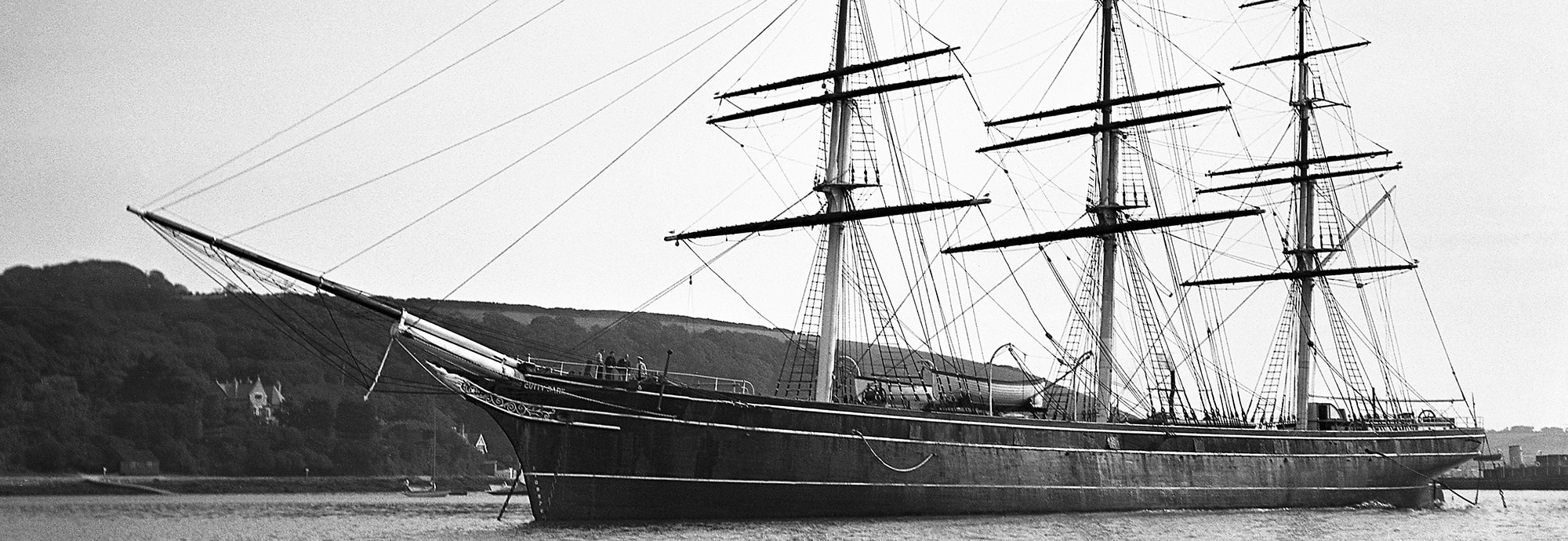

By Linda Batchelor
‘She was the fastest ship of her day, a grand ship, a ship that will last for ever’ – Captain George Moodie, the first Master of Cutty Sark.
In 1894 Wilfred Dowman was an apprentice seaman on the Hawksdale when the ship, owned by Iredale & Porter of Liverpool, was passed by the Cutty Sark, leaving them to windward in a few seconds and in ‘a manner which could not fail to impress’. Wilfred was at the start of his career at sea in which he became a commander in the mercantile marine, served in the Royal Navy Reserve in the First World War, owned a boatyard and ran a sea training school for boys.
However, he never forgot his first impressive sight of the Cutty Sark, and when in January 1922 the ageing ship, now called the Ferreira in Portuguese ownership, took shelter in Falmouth in need of repair, Captain Dowman was once again captivated. Despite her sorry state he resolved to purchase her, restore her to some of her past glory and use her as a training ship. The purchase was completed in October of 1922 and, now renamed Cutty Sark, the ship became a training ship moored in Falmouth until 1938.

Cutty Sark in Falmouth Harbour, September 1936. The Weller Collection © NMMC.
Captain Dowman had retired from life at sea and he and his wife Catharine had come to live in Cornwall at Trevissome House in Flushing in the early years of the 1920s. He had an interest in the Ponsharden Shipyard in Falmouth and he and Catharine had also set up a sea training scheme for ‘poor boys of good character’ in a 163-ton schooner named Lady of Avenel. The schooner had been built in 1874 in Falmouth by H. S. Trethowan for the owner Edward Dixon Anderton of Falmouth, and employed as a freighter especially in the granite trade from Cornwall. Sold out of Cornwall in 1900 she returned in 1921 owned by the Dowmans, who installed an auxiliary engine and refitted her as a training ship. The concept of training ships was close to the Dowmans’ hearts as they had met on a voyage from London to Sydney in 1912 on board the Port Jackson, a cadet training ship on which Wilfred was First Mate and Catharine was one of the three additional passengers.
Wilfred Harry Dowman was born in Birmingham in 1879 but his father died when he was young and he grew up with his mother in Birkenhead. At 13 he went to sea and was apprenticed on Hawksdale, where he had his momentous first sight of the Cutty Sark. By 1904 he had achieved his Master’s Certificate and remained with Iredale and Porter until 1912 having two commands for the Liverpool shipping firm during that time. Unfortunately the firm had to reduce their fleet and crew complements and it was then that Wilfred took the position of mate on the Port Jackson and met Catharine. Although he was married at the time Wilfred and Catharine became a couple. At the outbreak of war in 1914 Wilfred joined the Royal Naval Reserve and served at Gallipoli and on the White Sea Convoys before he was demobilised in 1919. He and Catharine eventually married in 1920 and made their home in Falmouth.
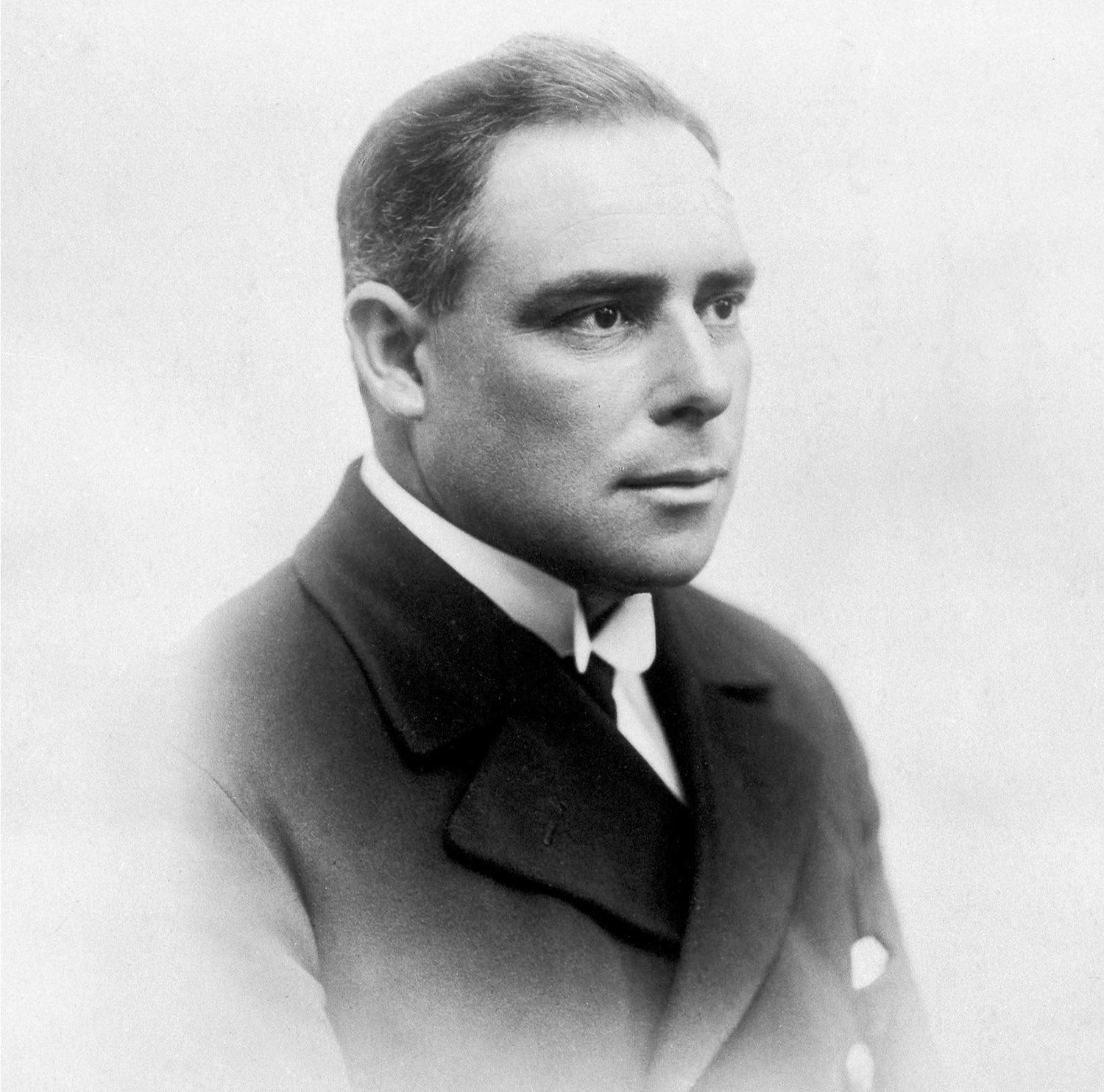
Captain Wilfred Harry Dowman 1879 – 1936 – Owner of Cutty Sark 1922 -1936.
Catharine was born in 1878 at Bocking near Braintree in Essex and was part of the Courtauld family. The family had come to England as Huguenot refugees at the end of the seventeenth century and had established themselves as silversmiths. In the nineteenth century Catharine’s uncle set up a successful silk weaving business in Essex and she and her siblings – three brothers and a sister – as a result had each inherited considerable wealth from the textile business. As Unitarians they were committed to using their wealth to promote social reform, which included extending suffrage, and were involved in trusts which supported education, hospitals and a variety of other charitable organisations.
They were also involved with the arts and the artistic community. Catharine established herself as an artist in early 1900 and joined the Central Society for Women’s Suffrage, becoming a founding member of the Artists’ Suffrage Atelier in 1909. By the following year Catharine was living with her elder sister Sydney Renee Courtauld at Bocken, a house designed for them by their architect brother John, near Great Missenden in Buckinghamshire. Sydney Renee was accompanying Catharine on the voyage to Australia on the Port Jackson when Catharine met Wilfred Dowman.
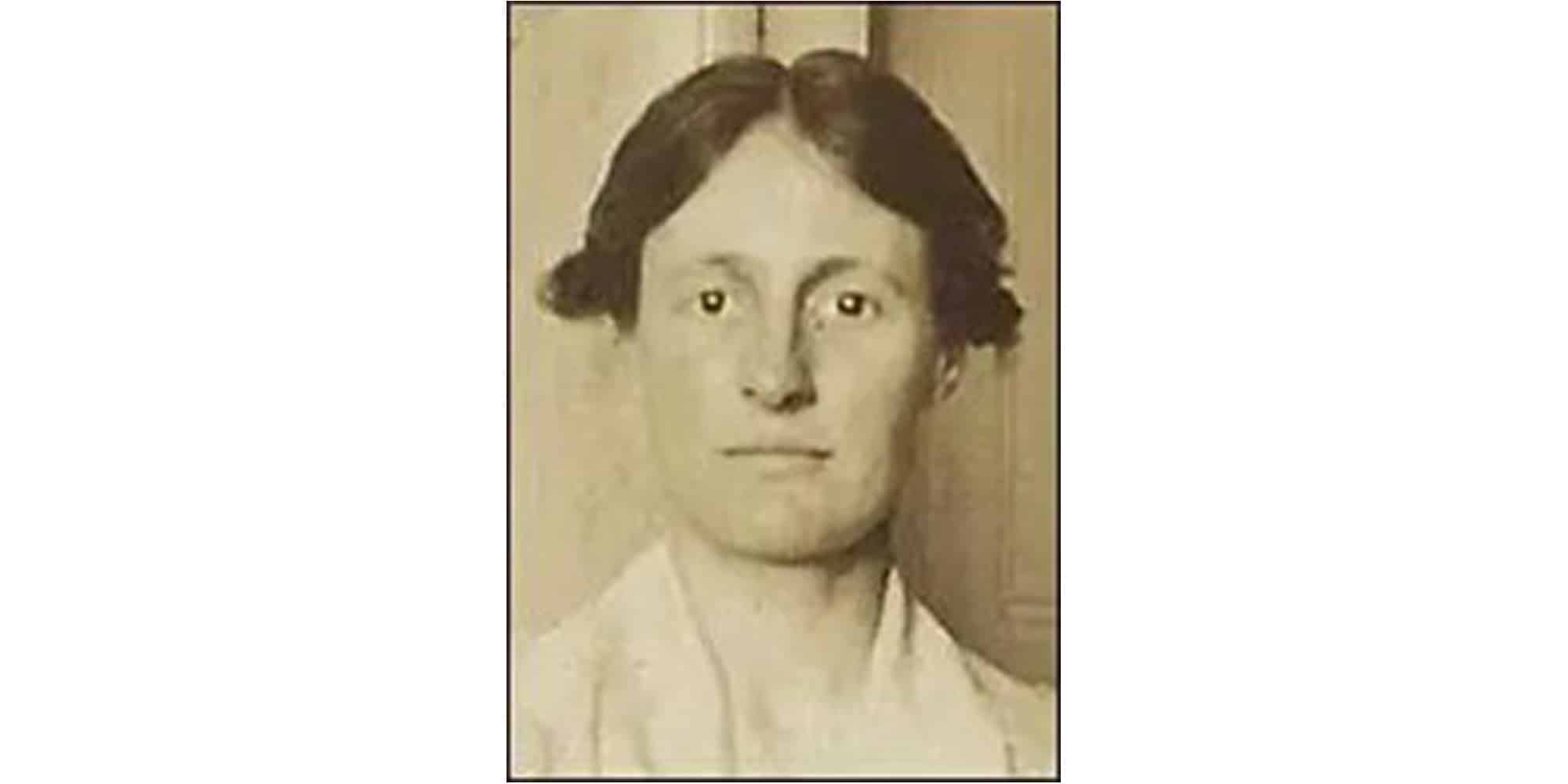
Catharine Courtauld/Dowman, 1878 – 1972.
The Port Jackson was part of Devitt and Moore’s Ocean Training Ships scheme. Devitt and Moore were a shipping line, originally with sailing ships engaged in the passenger and cargo trade with Australia. However, as the use of sailing ships began to decline they turned to using them for naval cadet training. In 1890 Lord Brassey had established a scheme to provide training for boys destined for service in the merchant navy and in 1906 Devitt and Moore had joined the scheme and purchased the Port Jackson, a wool clipper built in Aberdeen in 1882, and refitted her for training purposes whilst continuing in the Australian cargo trade carrying wool, tallow and government stores.
The first voyage to Sydney began in London in June 1906 and arrived in Australia in early November. The ship had a crew of 36 with a chaplain and a doctor, and the boys were taught by four nautical instructors and assisted in working the ship and handling the sails. The scheme was successful and in 1909 Devitt and Moore set up their Ocean Training Ships with shareholders from other shipping lines such as Cunard, Union Castle and Royal Mail Lines to train cadets for a career as officers in the merchant service. They also purchased a second ship named the Medway and before the First World War the two training ships were frequent and popular visitors to Sydney with cadets participating in regattas, rowing competitions and cricket matches.
It was the training voyage to Sydney in 1912 which had first brought Wilfred and Catharine together. When they married in 1920 Wilfred retired from active service at sea and they set up their own training scheme using the Lady of Avenel. On seeing Ferreira in Falmouth in 1922 and remembering the previous glory of Cutty Sark, Captain Dowman saw the potential for restoration and for the provision of a larger training ship. His initial attempts to buy her whilst in Falmouth were unsuccessful and she returned to Lisbon, was sold to other Portuguese owners and renamed Maria do Amparo. Captain Dowman persisted with his purchase negotiations despite many difficulties put in his way, particularly with the price which the owners put well above the commercial worth of the vessel.
Cutty Sark was built for the Scottish shipowner John (Jock) Willis, known as White Hat Willis, as a tea clipper at a cost of £16,150. The ship was designed by Hercules Linton of the shipbuilding firm of Scott & Linton of Dumbarton and built by the firm as a state-of-the-art clipper with a composite hull of iron and timber. At a gross tonnage of 963 tons the ship had an overall length of 280 feet, with 32 sails, 11 miles of rigging and a main mast that was 152 feet tall. Launched on 22 November 1869, the ship was registered in London to carry a crew of up to 28 under the command of Captain George Moodie, a senior captain of the Willis line.

John (Jock) Willis, White Hat Willis 1817 – 1899. Royal Museums Greenwich.
The name of the ship was chosen to reflect the speed of her passage through the water and was taken from the poem Tam O’Shanter by Robert Burns. In the poem, Tam – a farmer – is pursued in a furious chase by Nannie, a witch, who snatches at his horse’s tail and who wears a short undergarment known as a ‘cutty sark’. The figurehead on the bow, added at the time of the build and originally carved by Frederick Hellyer of Blackwall, represents Nannie grasping a tail of horsehair in one outstretched hand and wearing her ‘cutty sark’. Apprentices on the ship’s voyages were often required to replace the tail whilst in port with strands of unpicked rope. The figurehead adds to the ship’s streamlined profile and conveys a sense of speed through the waves which made Cutty Sark, with a maximum recorded speed 17.05 knots, one of the fastest of sailing ships.
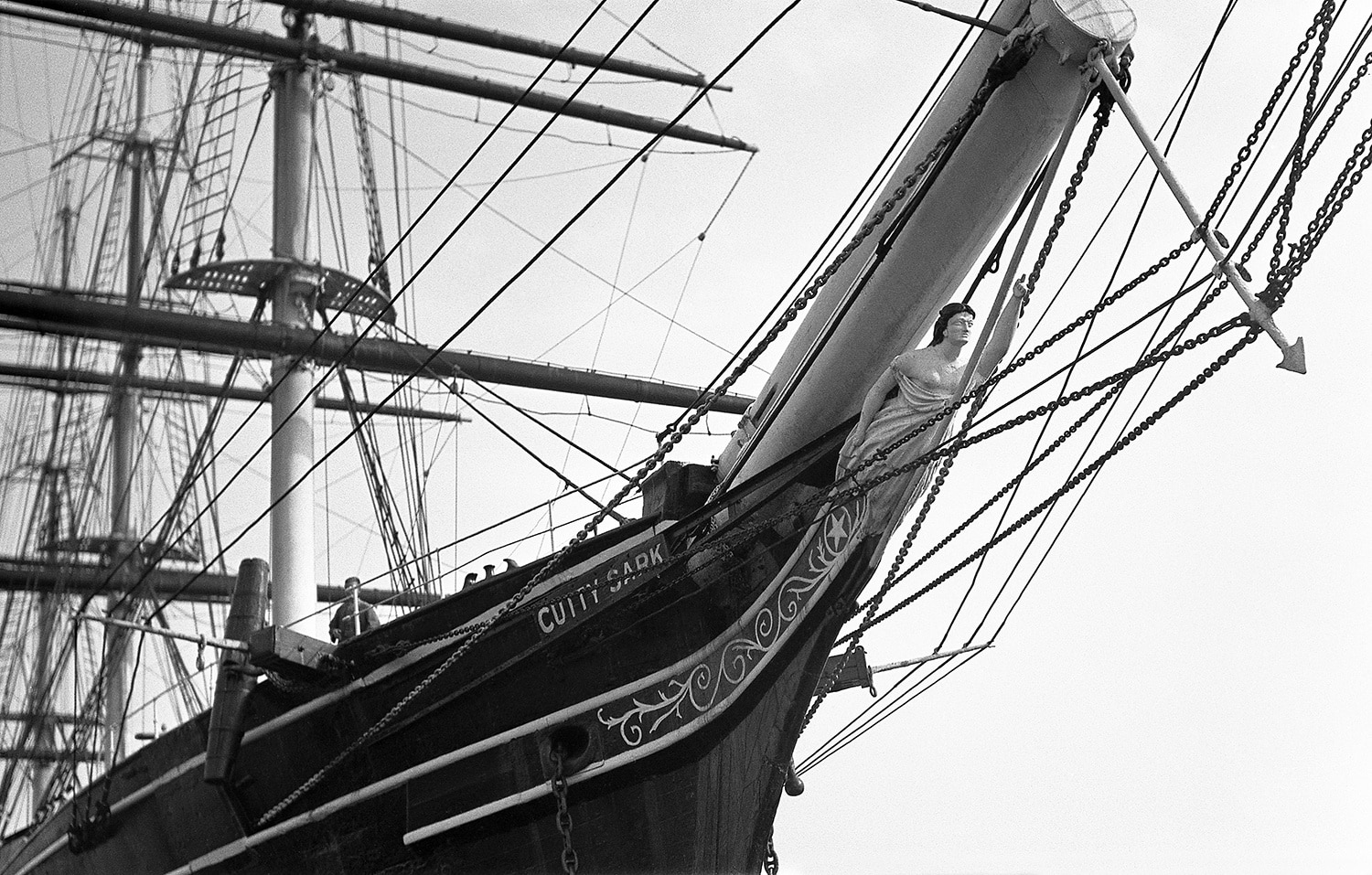
Figurehead of Cutty Sark in Falmouth Harbour, September 1936. The Weller Collection © NMMC.
Cutty Sark‘s sailing life began in the highly competitive tea trade where the speed of the clipper’s voyage to China and the return to home port in London with a cargo of tea was paramount in meeting market demands and making profit. The ship’s maiden voyage left London in February 1870 bound for Shanghai and proved her sailing qualities and speed, but her time in the tea trade was limited. The opening of the Suez Canal at the same time as the launch of Cutty Sark reduced the time of the voyage to the east making the clipper tea trade less profitable. There were to be only 8 such voyages and in 1883 the ship entered the wool trade with Australia which proved to be the most successful period of her career setting record voyage times and adding to her fame.
By the 1890s however steam was taking over from sail and Cutty Sark became increasingly less profitable and in 1892 was sold by Jock Willis to Portuguese owners, Ferreira & Co. As Ferreira, the ship was used in general cargo trade from her home port of Lisbon. The ship had a hard working and demanding life for the subsequent years and was in poor condition when she was seen in Falmouth by Captain Dowman in 1922.
Despite his initial failure to buy the ship and after the difficulties put in his way, finally in October 1922, with the wholehearted support of Catharine, the Dowmans were able to complete the purchase for £3,750. The ship was brought back to Falmouth by Captain Edward Rooney, a Falmouth pilot, and towed into the harbour by the Falmouth tug Triton.
Captain Dowman was determined to restore the re-named Cutty Sark to her original appearance and the work was undertaken by the Ponsharden shipyard. The ship was re-rigged to the original plans by the workers of R. S. Burt of the Little Falmouth Yacht Yard. Cutty Sark was then opened as a training ship by the Dowmans and moored off Trefusis Fields, Flushing. Numerous boys were trained over the years for careers in the Royal Navy or the Merchant Marine. Cadets were instructed in nautical skills and given practical, hands-on training in seamanship. Cutty Sark became a well known and loved sight in Falmouth and a subject for artists such as Henry Scott Tuke and photographers. The ship was also open to the public as a visitor attraction.
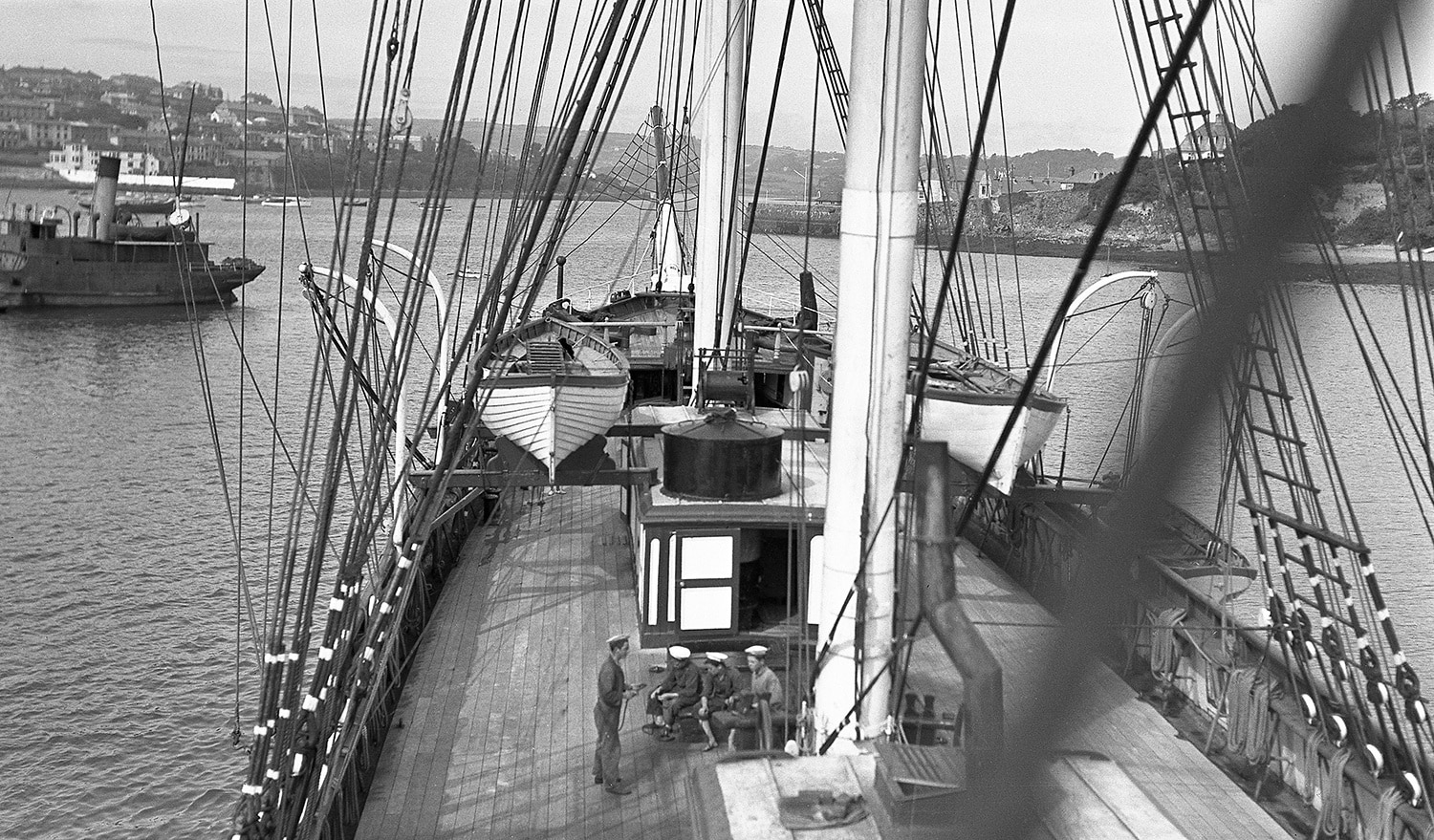
Cadets on board Cutty Sark in Falmouth Harbour, September 1936. The Weller Collection © NMMC.
Captain Dowman died in 1936 on a homeward voyage from the West Indies and was buried at sea. Following Wilfred’s death Catharine gave Cutty Sark to the Thames Nautical Training College with a gift of £5,000 to be used for maintenance. She was to be used as an auxiliary ship alongside the cadet ship HMS Worcester, moored at Greenhithe on the Thames. Cutty Sark left Falmouth in 1938 amidst many fond farewells and was sailed under tow by 12 cadets to the Thames. She remained as a cadet ship until the end of the Second World War.
In 1951 Cutty Sark was on display at the Festival of Britain and in 1954 the Cutty Sark Preservation Society and its President, the Duke of Edinburgh, were responsible for preserving the ship for the nation with the construction of a special dry dock at Greenwich. The ship was opened to the public by Queen Elizabeth II in 1957 and closed in 2006 for a conservation project during which there was a fire. Fortunately the ship was ‘saved’ and after restoration reopened in 2012.
Once again Cutty Sark, the last survivor of the clippers, renowned for her grace and speed, is opened to the public, a tribute to her designer and builders and a memorial to the men who sailed her and to the merchant navy. It is also a fitting tribute to the foresight and determination of Wilfred and Catharine Dowman in rescuing the ship in 1922. By doing so they ensured her survival and now once again she is restored in ‘a manner which could not fail to impress’.
The Bartlett Blog is written and produced by the volunteers who staff The Bartlett Maritime Research Centre and Library of National Maritime Museum Cornwall. Saving Cutty Sark – The Legacy of Wilfred and Catharine Dowman was written by Linda Batchelor.
The Bartlett Library holds a Collection of over 20,000 volumes and offers access to one of the finest collections of maritime reference books, periodicals and archival material. The Bartlett Blog reflects the diversity of material available in The Bartlett Library.

National Maritime
Museum Cornwall Trust
Discovery Quay
Falmouth Cornwall
TR11 3QY
View Map
See our opening hours
Tel: +44(0)1326 313388
Email: enquiries@nmmc.co.uk